Philosophy and Language of Music
Artist Statement
Over the last several years, I’ve come to great conflict in accepting the word “improvisation” and its common use in practice as being able to define what I and some of my colleagues are doing today.
Since “improvisation” has been adopted in the academic fields of inquiry, it, “improvisation” as an idea has come to mean almost anything conceptually. The word and the understanding of “improvisation” has lost its uniqueness and has reduced its capacity to capture the musical creation of artists such as: Scott Joplin, Ma Rainey, Louis Armstrong, Ferdinand “Jelly Roll” Morton, Thelonious Monk, Mary Lou Williams, Duke Ellington, Paul Gonsalves, John Lewis, Miles Davis, Bessie Smith, Billie Holiday, Charlie Parker, Ornette Coleman, Sun Ra, Lester Bowie, Alice Coltrane, George Russell, Geri Allen, Jeanne Lee, John Coltrane, Don Cherry, Cecil Taylor, Albert Ayler, Anthony Braxton, Leroy Jenkins, Carla Bley, Henry Threadgill, Roscoe Mitchell, Joseph Jarman, Muhal Richard Abrams and the creative music community.
There are five types of creation. The word Create has three types of classification, and Creation has two.
I offer the word Create as a clear definition, whose meaning is in direct context with the process of making art in the present moment. Create also refers to a performer in an ensemble who is creating their own part while the ensemble is playing music that is composed or learned.
In addition, the second use of the word Create means that a performer is creating a solo that is dominant in relationship to the ensemble. It is dominant because the soloist is not dominated by the ensemble’s performance, but the ensemble is depended upon the soloist. Also, it is a new element added to the music and has more power than a performer creating a line to match the composed music; here it’s just the opposite.
Third, if there are two or more soloing at the same time within the grid as a collective of soloists, this is known as a Creation.
Creation serves as the opposite of composition, and therefore it refers to a work of art in the same respect as composition. It is not unlike composition in this sense, it has signs and symbols which could also be found in composition. Also, unlike composition the performers use those signs and symbols to generate a work of art, whose dimensions are realized in the present moment. We call that art-object Creation. Creation should be copyrighted as a musical work owned by the composer-performer, soloist, and the collective soloists.
I am confident in the future of creative music, because one day there will be a group of young men and women scholars who will care about this music, and document their research concerning the art forms that the creative artist has realized. Those future scholars will put the ideas of the creative music back into the flow of world knowledge and in a profound language that any person can come to know what happened in the performance arts on this little planet, Earth.
The creative artists have always strived to make the world a better place through their ideas and music performances, serving all people. Creative music and the arts are for everyone and most specifically those who can and will make the effort to confront themselves in a direct search for truth. And because of their efforts, those people live adventurously in their discoveries of themselves and the secrets of life.
What we discover is right in front of us, and also enclosed inside of our hearts, just waiting for us to realize and accept our presence on this planet.
What defines all of us as human beings is the inspiration and knowledge to make coherent choices, informed through science, art, and authentic spiritual practice to develop a genuine care for others and the world we live in.
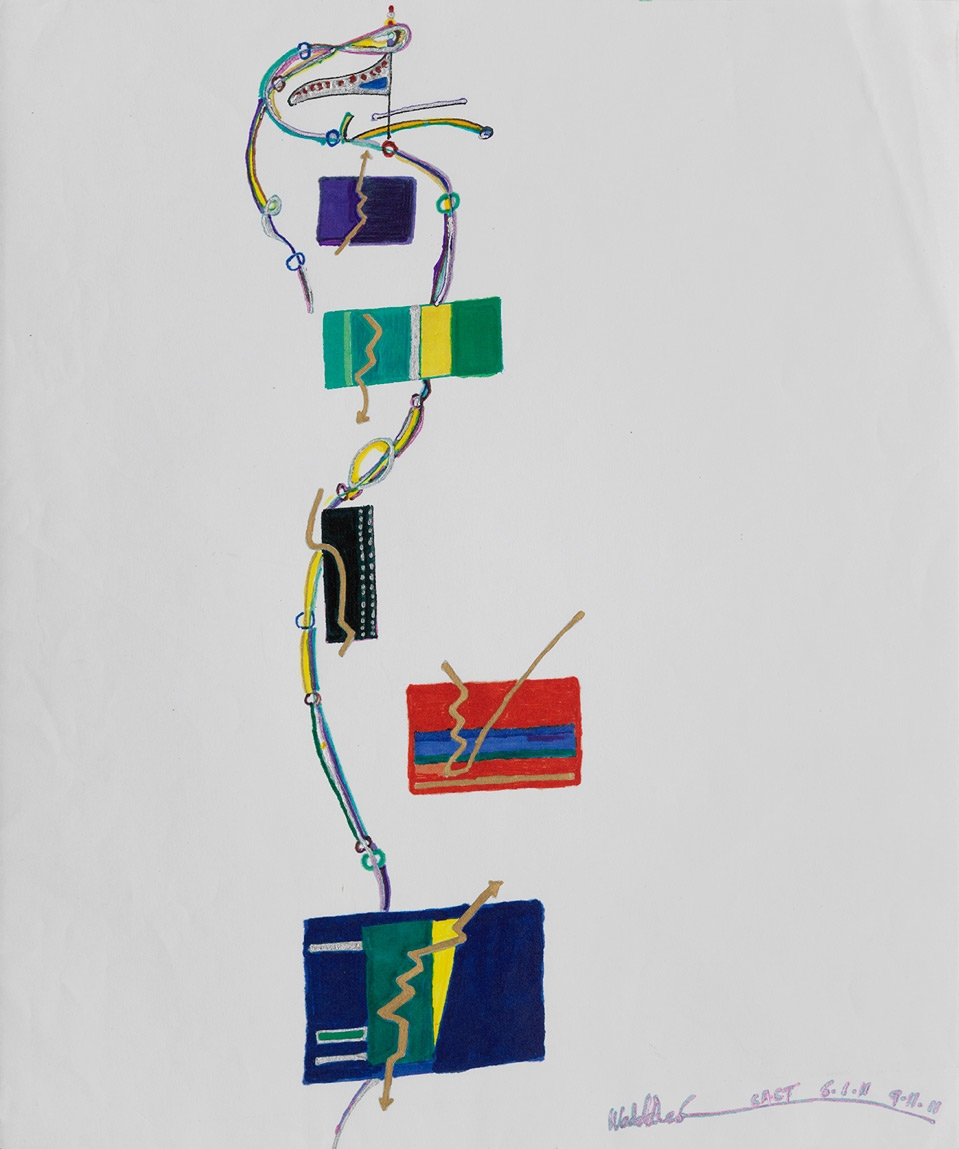
Sonic Rivers
Luminous Axis
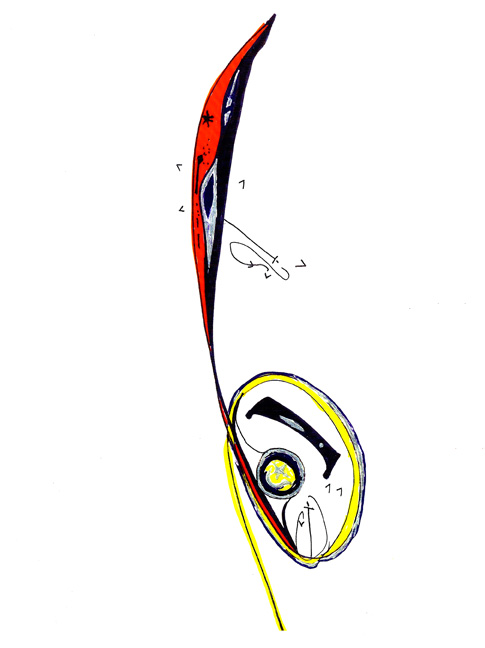
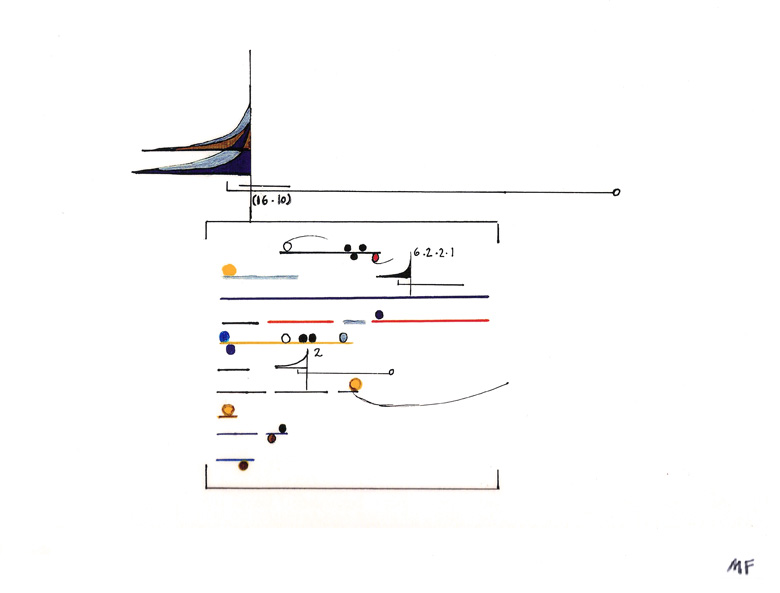
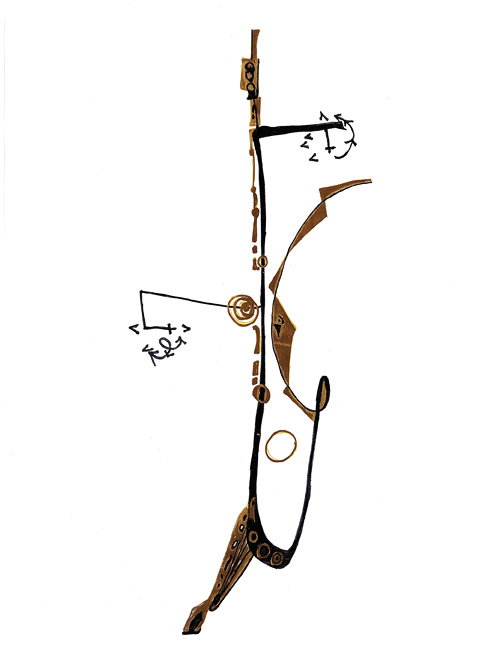
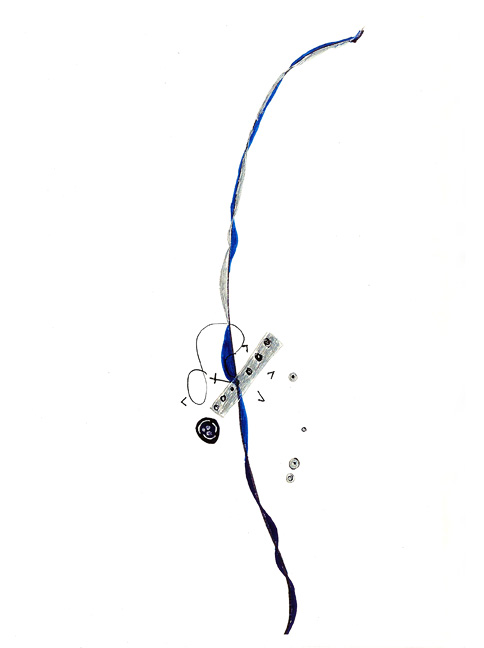
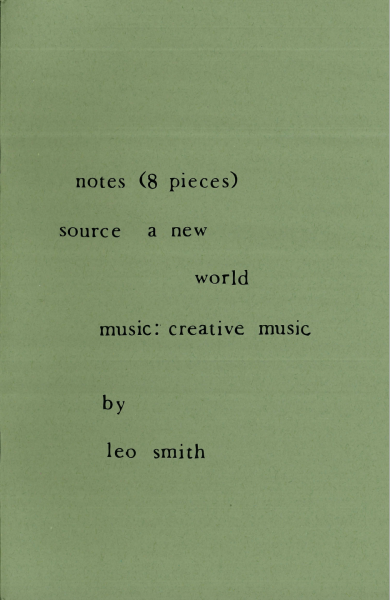
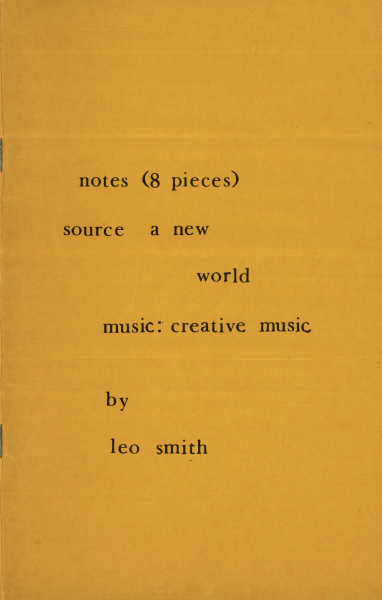
notes (8 pieces ) | source | a new | world | music: creative music
by Leo Smith © 1973
Part 1
notes
on my
music (part 1)
the concept that i employ in my music is to consider each performer as a complete unit with each having his or her own center from which each performs independently of any other, and with this respect of autonomy the independent center of the improvisation is continuously changing depending upon the force created by individual centers at any instance from any of the units. the idea is that each improviser creates as an element of the whole, only responding to that which he is creating within himself instead of responding to the total creative energy of the different units. this attitude frees the sound-rhythm elements in an improvisation from being realized through dependent re-action. this is the fundamental principle underlining my music, in that it extends into all the source-areas of music-making, i.e. each single rhythm-sound, or a series of sound-rhythm is a complete improvisation. in other words, each element is autonomous in its relationship in the improvisation. therefore, there is no intent towards time as a period of development. rather, time is employed as an element of space: space that is determined between the distance of two sound-rhythms (here the reference to rhythm is in reference to its absoluteness: the sum of the elements and the placement of them) and space/silence that is the absence of audible sound-rhythm (just as each sound-rhythm is considered an autonomous element in an improvisation, so, too, must space and space/silence be considered; and when space and space/silence are really-realized, then we will know so well how to perceive and appreciate their uniqueness each time they appear, as easily as we perceive and appreciate the uniqueness of each sound-rhythm): i seek another dimension in music.
the forms that i use in my music other than some of the traditional or contemporary forms are EeLO’jsZ and afmie. EeLO’jsz is an ensemble-orchestra,form for improvisers, and simply refers to the grouping together of more than one orchestra, more than one ensemble, or several orchestras with one or more ensembles in such a way as to preserve the autonomy of each improviser within a group, each group within the orchestra, and each improviser within the unit total. afmie is an art-dance-music form, where the music and dance elements rely upon improvisation for deliverance.
the dance is scored as sound-rhythm movement, and the symbols used for both musician and dancer are the same. here, too, the movements for the dance are in the the same relationship to each other and to the sound-rhythms as was outlined earlier for the music alone (i.e. autonomous). so, the elements of the dance as well as of the music are conceived without past or future.
i am an improviser, and my music is for the improviser. in most cases, my improvisations are conceived for multi-instrumentalists, i.e. for those who approach all of their instruments as one complete instrument, who perform on all of their instruments as if they were only one instrument. the attitude of the multi-instrumentalist should be the same as one who performs on only one instrument. this concept of all instruments as component parts of the total instrument offers the improviser a world of sound-rhythm as diverse as the many different component parts of the instrument.
Part 2
n
o
t
e
s
(part 2)
the wonder and gorgeousness of nature –
I’ve heard the sounds of the crickets, the birds, the whirling about and clinging of the wind, the floating waves ‘ and clashing of water against rocks, the love of thunder and beauty that prevails during and after the lightening – the – toiling of souls throughout the world in suffering – the moments of realization, of oneness, of realness in all of these make and contribute to the wholeness of my music – the sound- rhythm beyond – beyond – is what i’m after through this precious and glorious art of the black man – this improvisational music that i see, that i feel, that bursts all about us in this world, that’s conveyed to us from the many different other worlds and that’s held intact through our minds from the universe – these are life sources that bring forth love through the creative ability of all man – these are the sources that spur, that prompt the nowness, right-nowness,totality of the improviser, the creative improviser – our music is so personal (the improviser’s) that it takes in the natural world of all, the universal principles of all when created through the cosmic powers of the all, and this personalness as contributed by man are, too, of the source of the universal mind of all is interpreted by the man and therefore the creations of man cannot be universal – only cosmic creations are universal, as a mountain or valley or rivers and planets – i, a black man, a creative improviser, strive, through my improvisations and as an improviser to pay homage to the black, the blackness of a people, and that these creations themselves are for all, and the natural laws that are prevailing under these creations are relative as they are interpreted or perceived by beings of other peoples and thus they must extract what is of universality for themselves to each and every individual, but on the level and in the expression that is clothed in the garment of improvisation, and i contend that only the principles underlying these creations are universal to my people – i spoke earlier about the crickets and the rhythm of the little tadpole that floats about in a little pond, or the rhythm of the waves and wind, or in one’s life, the wholeness of sound-rhythm, of all that is created cosmically and all that one interprets (cultural) as beings on earth – these are the things that set in motion my thoughts,unfolds the heritage, my heritage. which/ from the (u.s.) north america to those ancient lands of africa and this present day modern africa – that is the lineage of my music – that is a part of the creative music of the improvisers – i humbly strive to create and document my music through this line of heritage with every conscious effort and action i feel the urge that is stronger than any other force a kinship, a realness, and realizing such, a heritage – and it is through this heritage that i find the most vital and creative energy for me as a person.
it is what makes my life complete with all its suffering and all of its pleasures and all that makes life life.
the speaking of the spirits, the essence of the spirit, the realness of the creation, spirit-drum – i feel is the essence of essence of improvisation.here i speak not of the drum physically or anatomically, but the spirit-drum (rhythm).
in the orchestral music of improvisation one can feel and know the presence of this spirit-drum. rhythm. rhythm propels the sounds that are unseparated from rhythm, and rhythm unseparated from sound but the attitude is the spirit- drumrhythm – as i stated in part one(note son my music) i tried to show the relationship in a philosophical sense how the set-ups and the principles underlining the sound-rhythm that takes place in my music and the consideration of space as also rhythm-sound that is incorporated – when rightly seen and felt these principles introduce a totally personal world that is in itself the spirit-drum – rhythm – rhythm -.
“rhythm, according to many africans, existed at the beginning of time and was often thought to be the absolute creator of the worlds and their inhabitants – it is therefore the very essence of the universe, the hidden fluid that runs through all beings – human, animal and vegetable – the magical point of contact and of participation, of man with nature” – i hold this to be the highest in essence in consideration of improvisation.
other
notes part 3
(the equality of all in struments and a few notes on a sound recording, creative music-1 — and other thoughts)
part 3 deals specifically with the fallacy that if the drum is not present then it is not black music (creative music); with the sound recording, creative music-1, which consists of 6 solo improvisations; and with the sound recording form. first a few misconceptions must be cleared up about the function of certain instruments in creative music. i’m specifically referring to the statements and attitudes of reasoning that hold that the drum is the center of black music. it is not the element but the spirit that is: rhythm. in other words, it is not the center as all evolves out of (as explained in part 2, the spirit-drum) but the center in the sense of the dominant-the controlling factor in the music. this is a misconcepti on as was with the trumpet and saxophone. critics have applied narrow concepts to this improvisational music so that they could easily write about and define it and dictate what is the essence of black music-creative music. the percussion, brasses, strings and any other beaten, plucked or wind blown instruments in improvisational music are equal — they are all equal in the creation of music, although the improvisers seem not to understand this and continue to roll along with the critics-ideal of himself and creative music. so the “front-line” dictates and controls what’s happening or feels that they are the only creative ones along with the drummer (or “solo” and “rhythm section”): and the drummer propels the “solo” in their creations, or so says the critics. (one has to only take note of the unfairness in the documented evidence of creative music. here one can find that only saxophones, trumpets, pianos, and occasionally other instruments have been endowed with the honor of being “leaders” and thus most of the contributions to different periods of development in creative music have always been attributed to one individual, and never more than one at one time — highly unbalanced procedure.) i refer all those who hold these types of views to the continent of africa to consider the great master improvisers there in ancient and modern times. in this great music of our heritage, any instrument, including the voice, is performed (improvised) in solo (i.e. without accompaniment of drums). in fact if one has noticed, in african classical art music there is a string music, a percussion music, a vocal music, and different music of wind instruments (ivory trumpets, for example). no matter what size the ensembles are, all the instruments are given equal importance, and with that equal importance they are given their autonomy in relationship to time (no unison in time). regarding the orchestras, the same principles hold true. and to come straight across, or into the lands of north america we’ll find in the early orchestra and ensemble music of the african-american, the many flourishing-lines of equal independence (importance). one has only to look to fine recorded examples of early ensemble music to realize what i’m saying. for example, louis armstrong and the hot five ensemble. they recorded in chicago during a span of time that ran from november 12, 1925 through july, 1926. now, on none of the sound recorded during that period was there a drum used (allegedly, one of the reasons was because they couldn’t record the drums, but what i’m talking about is the actual documented fact of master music without drums, regardless of the circumstances ). although, hear me clear, i’m not saying that the spirit-essence of the drum is not there. i’m saying that all of the instruments are equally important, and hold equal, no matter what setting the music is performed in. now to go to further proof of what i’m talking about, consider “weatherbird”. this improvisation was recorded in 1928 and performed by only two improvisers: louis armstrong and earl hines. now this duo music, as you will have noticed if you’ve ever heard it, does not have drums, but the spirit-essence of the drums is there. the point that i’m trying to make is that when listening, if you listen to an orchestra, ensemble, or a solo, listen seriously to that only. do not listen with some strange outer third ear for something that’s not there. in other words, if a solo improvisation is taking place, do not suppose in your mind that you are hearing a solo and plus. that is absolutely an unintelligent approach to music. so i simply say: hear what you are hearing when you are hearing and you will never have illusions of what it is that you are hearing.
